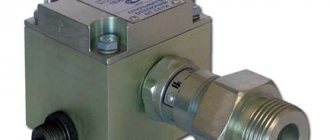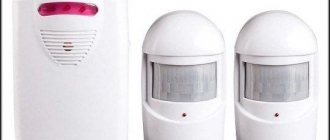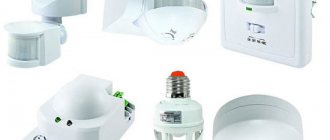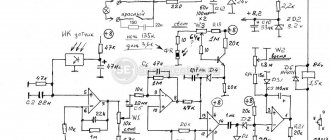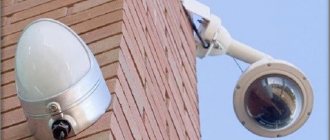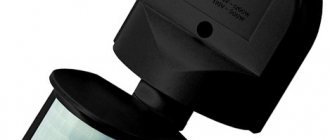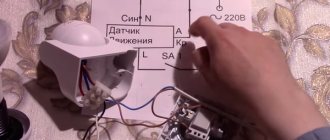Last updated January 2, 2022
A motion sensor is a sensitive device that detects the movement of living (and other) objects in a room, and then sends a signal to the appropriate equipment. Motion sensors were among the first to appear in security alarm systems - where they helped to detect the entry of an unauthorized person into a room or territory, and then turned on an alert. Today, the scope of application of these devices has expanded significantly and has become actively used in private housing for the most peaceful purposes. The introduction of motion sensors is especially active in smart home systems.
Types of motion sensors
There are many classifications of motion-recording devices, but the main principle remains the gradation principle according to the type of device. In order to sense movement, the device needs to register changes in certain parameters. This can be realized in various ways - with the help of microwaves, ultrasonic vibrations and other physical phenomena. Such sensors are active - they constantly emit a stream of radiation, and after the appearance of a moving body they register reflections of wave oscillations.
Expert opinion
Yakovlev Alexey Sergeevich
Electrician with 20 years of experience and extensive experience
In residential premises, including for integration with the Smart Home system, infrared sensors are most often used. They have a number of advantages that make them optimal for performing tasks.
Typical household model with average functionality
NV500 by PARADOX
Optics – a hybrid cylindrical-spherical lens with Fresnel lens segments with a viewing angle of 1020.
The radiation pattern is designed to provide uniform sensitivity throughout the controlled volume. Super Creep Zone – sabotage zone control function. Digital locking for animal detection up to 16 kg.
Two-level pulse counting using the APSP algorithm. Automatic temperature compensation. Automatic digital sensitivity adjustment of 5 levels. Tamper protection – solid state relay.
Operating principle of an infrared motion sensor
Heat emitted by living things is radiation in the infrared spectrum. Considering that warm-blooded animals have a body temperature of 30 to 40 ° C, the strength of these rays is quite high and can be recorded by sensitive equipment. Inside the infrared sensor there is usually a system of lenses (in cheaper ones - one segment), which concentrate thermal radiation on a special element - a pyrodetector.
When a certain threshold is exceeded (usually it is set during installation and is largely determined by the sensitivity of the device), the pyroelectric element is triggered and sends a signal to associated devices.
On a note. Heat is emitted not only by living beings, but also by an air conditioner that operates for heating and a heated floor system. Therefore, motion sensors are designed in such a way that they are triggered by an abrupt change - that is, the appearance of a person in the field of view. True, if the sun in the window “shoots” rays into the lens of the infrared sensor, the device will work. That is why it is not placed opposite the window and is always hung from the ceiling.
Operating principle of DD
Motion sensor 12 volt
To understand how motion sensors work, you need to consider the IR detector circuit, understand what the device consists of, and how its elements function.
Design and operating diagram of the IKDD
The design principle of the DD circuit is based on a combination of three elements: an optical system, a pyro receiver and a signal processing unit.
Optical system
Sensor optics is what is called a translucent curved plate on the facade of the housing or moving head of the device. The plastic is covered on the inside with many small lenses. Its function is to focus infrared radiation emanating from the controlled space onto the photocells of the pyroelectric receiver.
Pyro receiver
The pyrosensitive element reacts sensitively to changes in the focusing of the optical system. If an object appears in the observation zone, the microprocessor of the pyro-receiver transmits a signal to the operating unit.
Signal processing block
The operating system is a complex electronic circuit that, in addition to recording movement, controls the device settings modes. The main function of the block is to send a signal to a relay that turns on one or another connected equipment (light, alarm, etc.).
The fact that the sensor is in operating mode is indicated by a red LED indicator built into the front panel. In standby mode the LED does not light up.
Wall option
What are the advantages of an infrared sensor
A device that records movement by thermal radiation has significant pros and cons:
pros
Low current consumption. Unlike active sensors that emit ultrasound or microwaves, the infrared sensor belongs to the family of passive sensors; power consumption is very low, which allows it to be installed autonomously, powered by a battery.
There are no false alarms for moving objects other than warm-blooded ones (for example, a robot vacuum cleaner, a swaying curtain by a window).
It can easily be connected to a smart home gateway (hub) or directly connected to a lighting device via an electromagnetic relay.
Minuses
Not too large coverage area (usually up to 10 meters).
Failure to operate at too high or low temperatures.
But it is precisely these shortcomings that are insignificant in indoor use conditions, because there is no frost in the apartment and house, and people do not wear fur coats. As for the coverage area, it is always limited by the dimensions of the room.
These features allow us to consider infrared sensors as the optimal tool for automating smart home scenarios.
Using the CC1111 Wireless USB Adapter and SmartRF Software to Capture Packets
The second method the CC1111 USB EVM Kit wireless USB adapter and the SmartRF™ Protocol Packet Sniffer program. The data is displayed as is on the screen, but the data stream can be further processed and used to test and characterize the system. After installing the packet analysis program (version 2.18.1 at the time of writing), the procedure for detecting transmitted data is as follows:
- Connect the CC1111 USB adapter to a free USB port on a computer with traffic interception software installed.
- Launch the packet analysis program, select the “Generic” protocol and click the “Start” button (Figure 9).
Rice. 9. Window for launching the traffic interception program
- Configure CC1111 to display data packets correctly. Select the “Radio Configuration” tab. Click on the “Browse...” button located under the “Register settings” tab. Open the file TIDA-00489_CC1111.prs. Select and double-click on “TIDA-00489_CC1111” to apply the register settings shown in Figure 10.
Rice. 10. Window for setting up the configuration of the traffic interception program
- To start the packet interception process, click the 'Play' button on the top panel of the program window.
- Packet sniffing software can detect foreign data packets. Apply a filter to view only valid data packets. Figure 11 shows an example of an unfiltered data view window. The highlighted line shows a foreign data packet.
Rice. 11. Window of unfiltered data packets
- To add a filter that displays only reliable packets, select the “Display filter” tab. In the “Field Name” field, select “FCS” from the drop-down list. Click on the "First" button. Change the filter settings to show only packets with o by entering “FCS = OK” in the “Filter condition” field, then click the “Add” button, and then the “Apply” button. Figure 12 shows examples of the filtered data view window.
Rice. 12. Window of filtered data packets
- To export intercepted filtered packets, click on the “Save the current session” button on the toolbar (floppy disk icon) or pause packet interception and click File → Save data... from the file context menu. In both cases, the program will offer to save the displayed data as a capture data package (file with the .psd extension).
- Use a hex editor program such as HexEdit to display the data from the .psd file in a human-readable format.
- Open the .psd file in HexEdit, click Tools → Options. In the HexEdit Options window, click Document → Display and change the Columns value to 2066. Click Edit → Select All and Edit → Copy As Hex Text. Open a text editor (such as Notepad), paste the hexadecimal numbers as text, and save the text file. This text file can be imported into a Microsoft® Excel® spreadsheet for further analysis. For more information about the format of the intercepted data packet, click Help → User Manual.
Power consumption characteristics
The current consumption of various functional units of the sensor was measured on a preliminary prototype. This information was used during the development process to find a reasonable compromise between battery life on the one hand and the sensitivity characteristics of the motion detector and the sensor supply voltage on the other. The same data was used for comparison with the final prototype test results to ensure good correlation between the preliminary and final results. In addition, the prototype tested the dependence of current consumption on supply voltage. The results of measuring current consumption are shown in tables 1 and 2.
As can be seen from the data given in Table 1, there is a good correlation between the current consumption values measured in the breadboard and the nominal calculated values. The data from Table 2 also shows a small positive dependence of current consumption on supply voltage. This means that the calculation of battery life based on average current consumption is carried out with a margin due to the fact that the current consumption will decrease as the battery ages.
Table 1. Current consumption of various sensor functional units
| Functional unit of the sensor | Current consumption in sleep mode, nA | |
| Nominal value | Measured value | |
| Motion Detector | 600 | 594 |
| Dual comparator | 150 | 150 |
| Divider | 50 | 50 |
| Op-amp 1 | 374 | 360 |
| Op-amp 2 | 409 | 380 |
| MK CC1310 | 100 | 120 |
| Total for sensor | 1683 | 1654 |
The two main operating modes shown in Table 2 correspond to the modes described in Figure 5. The Current Difference column shows how much current consumption increases from sleep to active mode, a value used in calculating battery life. The last line in Table 2 is added for informational purposes only, since such a low supply voltage significantly increases the output noise of the IR motion detector, resulting in an increased likelihood of false alarms. Current consumption at the minimum supply voltage was measured using a custom program that kept the MCU in sleep mode and ignored interrupts, as a result of which Table 2 does not contain data on current consumption in active mode at this supply voltage.
Table 2. Sensor current consumption in various operating modes
| Supply voltage Vcc, V | Current consumption, µA | ||
| Sleep mode | Active mode | Current difference | |
| 3,8 | 1,75 | 2,46 | 0,71 |
| 3,6 | 1,73 | 2,45 | 0,72 |
| 3,3 | 1,69 | 2,36 | 0,67 |
| 3,0 | 1,65 | 2,3 | 0,65 |
| 2,7 | 1,64 | 2,28 | 0,64 |
| 2,4 | 1,6 | 2,22 | 0,62 |
| 2,2 | 1,59 | – | – |
Energy consumption data was used in the next section to calculate projected battery life under various operating conditions.
Application area
A motion sensor is a universal device that can be used in a wide variety of household areas. The industrial application of such devices is even wider, but this is a separate topic.
Home lighting automation
The most common scenario used in residential premises - apartments and houses. When a motion detector is triggered, the sensor sends a signal to the controller, which turns on the lighting in the corresponding room. This can be either local or general light, as well as all sorts of additional sources: LED strips, bedside area lighting, and more.
The use of lighting sensors to automate turning lights on and off in rooms allows you to save up to 40% on electricity.
Together with the installation of infrared sensors, it is possible to resolve the situation when the owners leave the room, forgetting to turn off the light in it.
Security functions
This use of thermal sensing equipment was a first and continues to produce good results. Using a motion sensor you can:
- Organize the sending of a push message to the owner’s smartphone (the function is activated when leaving the apartment).
- Program the activation of the alarm, including sending an alarm signal to the security post.
- View the time of arrival of family members in the “log” section, where the history of sensor activations is kept.
Climate control
This combination is used less frequently than with lighting, but it also occurs. Based on the sensor signal, devices that maintain the parameters of cold and heat in the apartment can be turned on: batteries or a heated floor system, air conditioning, fan, humidifier and other devices. Thus, maximum energy expenditure occurs only at the right time, and not constantly.
It is worth noting that the widespread use of infrared motion sensors in the field of home climate control is hampered by the phenomenon of thermal inertia. In order to fully warm up a room, it takes time - and this must be done in advance, before entering it. As a result, a comfortable temperature is not achieved immediately, but when this is often not necessary, the person goes to another place.
Installation options
An infrared sensor can be connected using a variety of schemes. The most frequently requested diagrams are those indicating the connection of the product to lighting fixtures. Connecting an IR sensor is possible in two ways:
- through a junction box;
- directly at the location.
Whatever method you choose, you need a special scheme that meets your specific needs. The easiest way to connect this type of detector is to install it using a switch. In this situation, the lamp is connected to another electrical circuit. Here, if the switch is completely removed, the sensor can independently be responsible for turning the light on and off. A diagram of such a connection is shown below.
Connection diagram via switch
You can connect the detector directly to the wiring. Here you should determine the wire going to the lamp. We extend a new one from it and connect it to the red contact of the sensor. The connection diagram in this situation is as follows.
Wiring connection diagram
In order for the sensor to work properly, the connection diagram must be strictly followed.
Criteria for selecting an infrared motion sensor
All devices that are on the market are very similar to each other, however, they also have enough differences that will seriously affect the practice of their use in the smart home system.
Nutrition
All sensors are divided into wired and wireless. The former receive power via a cable, the latter require a battery or even a regular battery for power, which also lasts a long time due to its low power consumption.
On a note. In household wireless sensors for the smart home system, a CR2032 lithium battery is most often used. It lasts on average for one and a half to two years.
Each type has its own advantages: wired devices operate from a constant power supply, but wireless ones are easier to place - there is no need to lay a low-current cable.
Data transfer
Here everything comes down to wires again. Sensors can be connected to the gateway directly, through a system of cables hidden behind suspended ceilings, baseboards or in grooves. Wireless devices connect to the hub via Wi-Fi or Bluetooth. For example, the Aqara system uses a special Zigbee protocol.
Viewing angle
It usually depends on the location of the sensor. Devices that are mounted on the wall usually cover 150 – 180°. If we talk about the ceiling sensor, it has an all-round view and registers any movement in the room within its range.
Radius of action
That is, the range of the device. For household infrared sensors, it rarely exceeds 7–9 meters. However, more is usually not necessary. For outdoor installation, you should choose more powerful and sensitive models with a range of up to 15 m.
Features of accommodation
Most often, sensors are placed either on walls (or any other vertical surfaces) or on the ceiling. The first models have a lens hemisphere in the front part, the second - at the bottom. Sometimes sensors are placed in a corner to achieve optimal coverage.
Some models come with a stand included. This configuration makes both placement options possible.
Photocell equipped
Thanks to an additional photo sensor, the device recognizes the level of illumination and does not turn on the light during the day when it is not required.
Disadvantages of the model
All devices have certain disadvantages. And they must be taken into account when choosing a product to create an automated system for turning on lighting in the house or on the street. Typically, the vast majority of shortcomings are based on the design features of the product, as well as the principle of its operation. When considering infrared models, the negative aspects of their installation include:
- presence of false positives. False positives are due to the fact that the device’s sensor is capable of perceiving any infrared radiation. For example, a false alarm can occur from excessively heated air, which occurs outside in hot weather or comes from an air conditioner, radiators, heaters and radiators;
Popular motion sensors
Infrared motion sensors today can be purchased both in electrical stores and on various online trading platforms.
REV DDV-3
A small sensor in element format for self-assembly and connection of a motion response system. Designed for hidden installation. Compact, simple, but the range is small. Has a built-in shutdown timer with regulator.
IEK LDD10-009-1100-001
A powerful sensor with a range of 12 m, allowing it to be placed outdoors. Moisture protection is only nominal, against splashes (class IP44), so placement under a canopy is recommended. With fairly large sizes, the regulators are very small - you will need tweezers to adjust them.
IEK LDD11-024-1100-001
Another device from IEK, this time of the hemispherical type. Both wall and ceiling installation are allowed. The switches are located under the cover. It has a built-in relay, but the click is a moderately quiet sound.
REV 15283 5
A classic wall sensor with a range of 12 m, it is intended for placement in long corridors, as well as in areas of private houses. The device “lacks stars from the sky,” but honestly performs all functions. The only disappointment is the small viewing angle – 110°.
TDM ELECTRIC SQ0324-0016
An original solution - the sensor is combined with an E27 socket, screwed into a standard socket and serves as a kind of adapter for the light bulb it controls. It can be a good solution if you need to install only one light source that turns on when moving.
HIPER IoT M1
Good design, excellent sensitivity, convenience and versatility of installation - everything for a smart home system. The communication protocol with the gateway is Wi-Fi, via a router. The disadvantages include a rather long response time, as well as occasional malfunctions that require a reboot.
Aqara Motion Sensor
The sensor interfaces not only with the proprietary Aqara gateway, but also with Apple Homekit, as well as the general Xiaomi MiHome. Thanks to the ball foot, it can be placed anywhere. The software's scripting implementation makes it one of the best options.
Best models
The most popular options for motion sensors are:
Flash-SRP600, LC 100 (price – 403.1 rub.)
The Flash model does not trigger the appearance of animals if their weight is less than 25 kg.
Crow LC 102 (price – RUB 1,397.96)
Crow LC102, SWAN 1000 devices are combined, they are very accurate.
SWAN 1000 (price-1410 rub.)
Guardian P-314 (price -2,913.03 rub.)
They are used in the field of security. It does not react to animal movements. The work extends to the determination of IR radiation from people. When IR radiation is detected, the sensor determines the weight of the object and signals to the remote control when it is more than 20 kg.
Advantages:
- ease of installation;
- has a fashionable design;
- it can be installed outdoors;
PIR-3SP (price – 2890 rub.)
Among wireless DDs, PIR-3SP is in great demand. It also does not react to animal movements and is used in the field of object protection.
The incoming signal is processed by a microprocessor, which additionally checks the information.
The advantages of the device are:
- sending test signals to the central unit;
- when the battery is low, a signal sounds;
- application of a data encryption protocol with a code;
Question answer
Will the sensor respond to pets?
For small ones - no, but for large ones, over 20 kg - yes. To prevent this from happening, you should reduce the sensitivity.
How is a motion sensor different from a presence sensor?
There are no presence sensors as such - it's just a marketing name for sensitive infrared devices. They read even the slightest movement, creating the illusion of presence recognition.
How to make sure that the light does not stay on for a long time after being turned on by the sensor, for example, on the stairs?
To do this, you need to set a shorter delay - for example, half a minute - this is quite enough to get up.
Literature
- Application Report: Reverse Current/Battery Protection Circuits, https://www.ti.com/lit/an/slva139/slva139.pdf.
- White Paper SWRA349: Coin cells and peak current draw, https://www.ti.com/lit/wp/swra349/swra349.pdf.
- A quick start to developing an 868 MHz wireless channel on the CC1310. Electronics News No. 3, 2016
Obtaining technical information, ordering samples, ordering and delivery.
•••
Operation principle and conditions
The device records the dynamics of changes in the thermal radiation of the object and the general background.
Monitoring is carried out over a certain period of time. To trigger, certain conditions must be met. First, a change in the position of the object in space controlled by the detector.
Secondly, the trajectory must be perpendicular to the direction of the IR radiation generated by the device.
Thirdly, the distance from the radiation source must be sufficient for its level of perception, that is, it must determine the temperature difference between the object (including clothing) and the surrounding background.
Rules for the operation of information kiosks, multimedia stands, tables
There are several different ways to apply a particular technology. In this article we will not give a detailed answer, but will briefly give a couple of examples that we personally encountered in practice. The first of these is the operation of street information kiosks - we strongly recommend using and installing only projective capacitive screens, industrial type, which are vandal-proof and have high brightness.
Multimedia interactive stands - here at your personal discretion. If you are worried that your sleeve will touch the screen and it will interfere with your presentation, then an infrared frame is not recommended.
Children's sensory tables - as practice has shown, there are no strict preferences here, and the emphasis is only on the organization's budget. Children will be happy with a new modern toy, regardless of the touch detection technology.
Screens do not require special care; the main thing is to treat the devices with care and keep the IR frame area clean and free of foreign objects.
